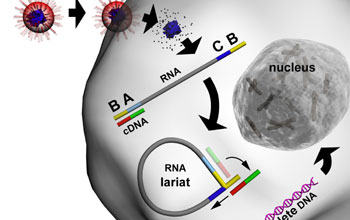Multimedia Gallery
The RNA lariat structure identified by Tom Menees at the University of Missouri-Kansas City.
The RNA lariat structure identified by Tom Menees at the University of Missouri-Kansas City may fill a key gap in the process by which retroviruses infect cells. Here, a virus is shown infecting a cell. The viral RNA, which contains the virus's genetic code, must then be converted to DNA. This process begins when the virus transcribes segments A and B of its RNA into complementary DNA (cDNA). Upon reaching the end of the RNA strand, the partially built cDNA must then jump to the other end of the strand (segments C and B) to continue; how this jump occurs has been a mystery. Though it still must be confirmed by further research, the RNA lariat structure may solve the problem by juxtaposing the duplicate B segments and allowing the partial cDNA to switch to the C-B end. A host-cell enzyme (called Dbr1) then breaks the lariat so the cDNA assembly can continue. Once completed, the double-stranded DNA inserts into the host chromosomes in the cell's nucleus where the cellular machinery is used to manufacture new copies of the virus.
Credit: Trent Schindler, National Science Foundation
Images credited to the National Science Foundation, a federal agency, are in the public domain. The images were created by employees of the United States Government as part of their official duties or prepared by contractors as "works for hire" for NSF. You may freely use NSF-credited images and, at your discretion, credit NSF with a "Courtesy: National Science Foundation" notation.
Additional information about general usage can be found in Conditions.
Also Available:
Download the high-resolution JPG version of the image. (393 KB)
Use your mouse to right-click (Mac users may need to Ctrl-click) the link above and choose the option that will save the file or target to your computer.
Related story: RNA Lariat May Tie Up Loose Ends to Decades-Old Mystery of Retrovirus Life Cycle



